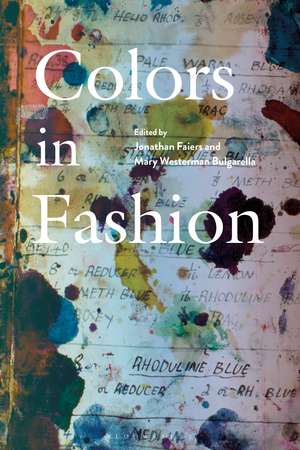Colors in Fashion
Editat de Professor Jonathan Faiers, Mary Westerman Bulgarellaen Limba Engleză Paperback – 11 iul 2018
Preț: 229.62 lei
Preț vechi: 291.43 lei
-21% Nou
43.94€ • 45.71$ • 36.28£
Carte disponibilă
Livrare economică 25 martie-08 aprilie
Specificații
ISBN-10: 1350077402
Pagini: 256
Ilustrații: 41 color and 20 bw illus
Dimensiuni: 156 x 234 x 18 mm
Greutate: 0.61 kg
Editura: Bloomsbury Publishing
Colecția Bloomsbury Visual Arts
Locul publicării:London, United Kingdom
Caracteristici
Notă biografică
Jonathan Faiers is Professor of Fashion Thinking at Winchester School of Art, University of Southampton, UK, publishes internationally on fashion and textiles, and is editor of the journal Luxury: History, Culture, Consumption. Mary Westerman Bulgarella is a consultant in the conservation, research, and display of historic textiles and dress, based in Florence, Italy and in Chicago, Illinois. She has been the Advisory Committee Coordinator of Costume Colloquium since its conception.
Cuprins
IntroductionJonathan Faiers (Winchester School of Art, UK) and Mary Westerman Bulgarella (Independent Consultant, Italy)Part 1: Color and Solidarity1. Color as Theme in the Ebony Fashion FairJoy Bivins (Chicago History Museum, USA)2. Purity and Parity: The White Dress of the Suffrage Movement in Early Twentieth-Century BritainKimberly Wahl (Ryerson University, Canada)3. Birds of the Same "Color" Flock Together: Color as Expression of Identity and Solidarity in Aso-Ebi Cloth of the YorubaMargaret Olugbemisola Areo (Ladoke Akintola University, Nigeria) and Adebowale Biodun Areo (National Museum, Nigeria)4. Contradictory Colors: Tricolor in Vichy France's Fashion CultureEmmanuelle Dirix (Manchester Metropolitan University, UK and Antwerp Fashion Academy, Beligum)Part 2: Color and Power5. Dress and Color at the Thai Court Piyanan Petcharaburanin and Alisa Saisavetvaree (Queen Sirikit Museum of Textiles, Thailand)6. 'Gold and Silver by Night': Queen Alexandra: A Life in Color Kate Strasdin (Falmouth University, UK)7. Lord Boston's Court Uniform: A Story of Color, Politics and the Psychology of BelongingDeirdre Murphy (Historic Royal Palaces, UK)8. Yellow is the New Red, or Clothing the Recession and How the Shade of Shame Became ChicJonathan Faiers (Winchester School of Art, UK)Part 3: Color and Innovation9. Color Before Technicolor: Colorized Fashion Films of the Silent EraMichelle Finamore (Museum of Fine Arts, Boston, USA) 10. Color as Concept: From International Klein Blue to Viktor & Rolf's "Bluescreen"Michal Lynn Shumate (School of the Art Institute of Chicago, USA)11. Tainted Love: Oscar Wilde's Toxic Green Carnation, Queerness and ChromophobiaAlison Matthews David (Ryerson University, Canada)12. Starlit Skies Blue versus Durindone BlueAnna Buruma (Liberty and Central Saint Martins, UK)Part 4: Color and Desire13.Rough Wolves in the Sheepcote: The Meanings of Fashionable Color 1909-1914Claire Rose (Royal School of Needlework, UK)14. 'Le noir étant la dominante de notre vêture .': The Many Meanings of Black in Post-War ParisBeatrice Behlen (Museum of London, UK)15. British Scarlet Broadcloth: The Perfect Red in Eastern Africa, c.1820 - 1885Sarah Fee (Royal Ontario Museum, Canada)16. Lives Lived: Archaeology of Faded IndigoKate Irvin (Rhode Island School of Design, USA)NotesBibliographyIndex
Recenzii
A series of fascinating essays by an internationally-spread group of authors ... it can be dipped into at will.
This book provides a comprehensive exploration of color's complex and fascinating relationship with fashion. Foregrounding how consumption and power structures have shaped the way color is worn, perceived and desired in a number of global contexts and historical periods, it is an essential book on how culture and society influence color.
Descriere
Color speaks a powerful cultural language, conveying political, sexual, and economic messages that, throughout history, have revealed how we relate to ourselves and our world. This ground-breaking compilation is the first to investigate how color in fashionable and ceremonial dress has played a significant social role, indicating acceptance and exclusion, convention and subversion.From the use of white in pioneering feminism to the penchant for black in post-war France, and from mystical scarlet broadcloth to the horrors of arsenic-laden green fashion, this publication demonstrates that color in dress is never straightforward. Divided into four parts - solidarity, power, innovation, and desire - each section highlights the often violent, emotional histories of color in dress across geographical, temporal and cultural boundaries. Underlying today's relaxed attitude to color lies a chromatic complexity that speaks of wars, migrations and economics. Bringing together cutting-edge chapters from leading scholars, it is essential reading for students of fashion, textiles, design, cultural studies and art history.


